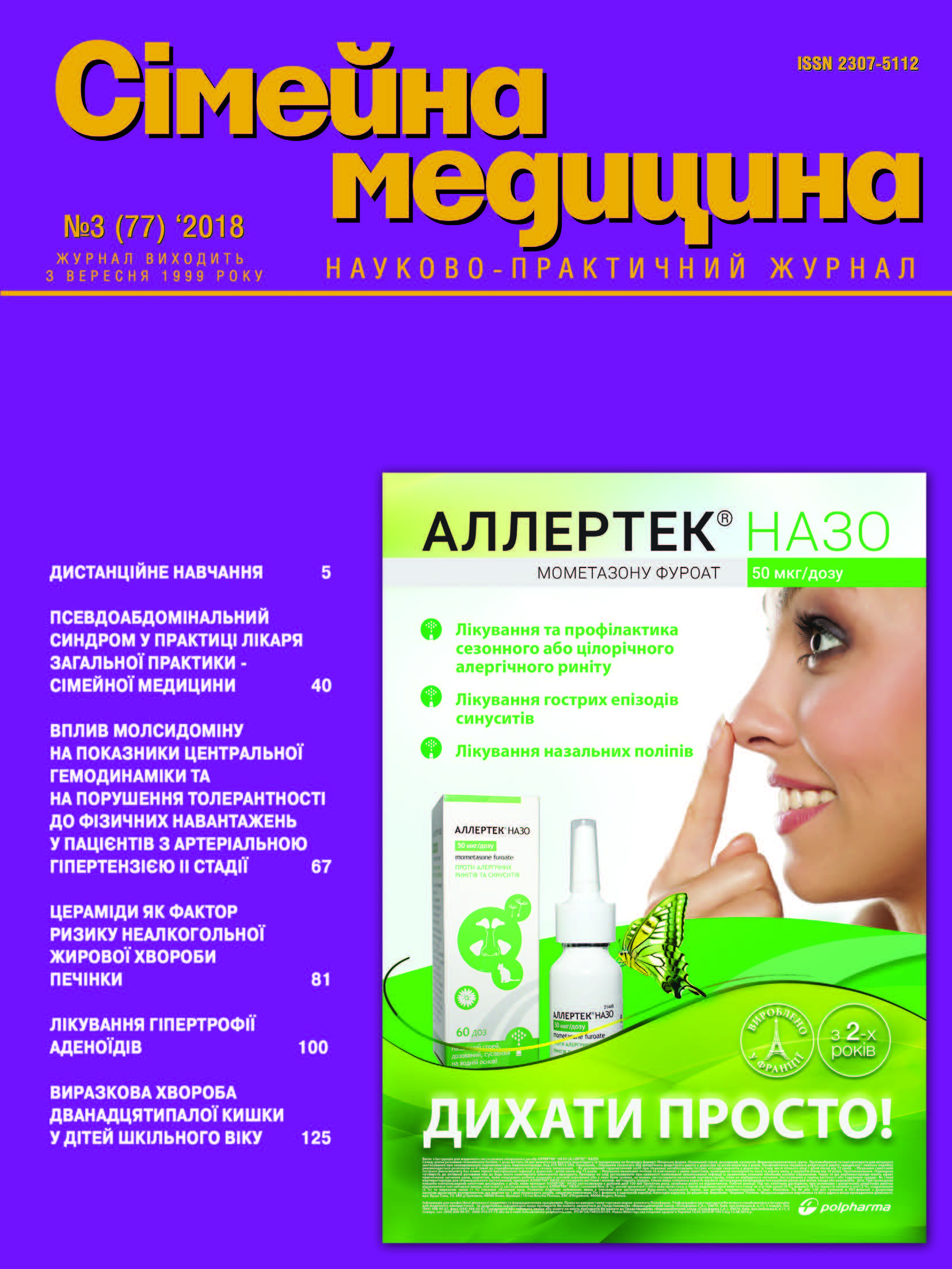The effect of complex treatment of patients with non-alcoholic steatohepatitis in combination with type 2 diabetes on the course of the inflammatory process: adiponectin and proinflammatory cytokines
##plugins.themes.bootstrap3.article.main##
Abstract
The objective: optimization of treatment for patients with nonalcoholic steatohepatitis (NASH), combined with type 2 diabetes by the pathogenetic approach, depending of the characteristics of the course of this disease.
Materials and methods. The study was carried out on 30 patients with NAFLD – in the NASH stage. Control group – 20 healthy persons. To identify the diagnosis of NAFLD, the clinical, laboratory, biochemical and instrumental studies were comprehensively taken into account, according to the examination standards for patients with pathology of the gastrointestinal tract.
Results. With the use of complex treatment with combined glucose reducing (gliclazidum and pioglitazoni hydrochloridum) and lipotropic (ademetioninum) therapy, the results of treatment showed their antiinflammatory effect with decreasing the levels of TNF-α, IL-6 and C-reactive protein, and an increase in the level of adiponectin.
Conclusion. A significant improvement in the subjective and objective state of patients was observed. The pain syndrome remained 1.8 times smaller than the number of patients before treatment; dyspeptic syndrome – decreased by 1.7 times, a decrease in appetite – a decrease of 1.9 times, asthenovegetative syndrome – a decrease of 1.9 times. Combined hypoglycemic and lipotropic therapy against baseline therapy positively influenced the state of hepatocytes: the activity of ALT, alkaline phosphatase, gamma-glutamyltranspeptidase decreased (p<0.05). Especially important was a significant reduction in the number of patients with stage III hepatosis – a decrease of 2.5 times. In all patients, the indices of cytolysis, mesenchymal-inflammatory syndrome, and protein and lipid metabolism parameters stabilized reliably.##plugins.themes.bootstrap3.article.details##

This work is licensed under a Creative Commons Attribution 4.0 International License.
Authors retain the copyright and grant the journal the first publication of original scientific articles under the Creative Commons Attribution 4.0 International License, which allows others to distribute work with acknowledgment of authorship and first publication in this journal.
References
Глушко Л.В., Коваль Н.М., Павелко Н.М. С-реактивний білок: діагностичні та прогностичні перспективи визначення в плазмі/сироватці крові й інших біологічних рідинах організму // Клінічна імунологія. Алергологія. Інфектологія. – 2010;7:58–61.
Динник Н.В., Свінціцький А.С., Соловйова Г.А., Богомаз В.М. Метод модифікації способу життя в пацієнтів із неалкогольною жировою хворобою печінки // Практикуючий лікар. – 2016;5:6–8.
Маньковский Б.Н. Тиазолидиндионы (глитазоны) – место в терапии больных сахарным диабетом 2-го типа // Therapia Український медичний вісник. – 2008;1:22.
Mykhal’chyshyn H.P., Bodnar Р.М., Kobyliak N.M. Correlation of adiponectin in patients with type 2 diabetes with nonalcoholic fatty liver disease depending on transaminases level // Lik Sprava. – 2014;5-6:130–8.
Орловський В.Ф., Муренець Н.О. Хронічне запалення при неалкогольній жировій хворобі печінки // Патологія. – 2010;7(3):99–101.
Сивкова А.А., Ларева Н.В., Лузина Е.В. Патогенетическое значение цитокинов в формировании и прогрессировании неалкогольной жировой болезни печени // Сибирский медицинский журнал. – 2012;4:56–8.
Стилиди Е.И. Роль фактора некроза опухоли альфа и интерлейкина-6 в патогенезе неалкогольного стеатогепатита // Кримський терапевтичний журнал. – 2012;№1:9–18.
Уніфікований клінічний протокол первинної, вторинної (спеціалізованої) медичної допомоги. Неалкогольний стеатогепатит / Наказ Міністерства охорони здоров’я України 06 листопада 2014 року № 826. http://mtd.dec.gov.ua/images/dodatki/2014_826Gepatyty/2014_826_YKPMD_NSTPT.pdf
Achari A.E., Jain S.K. Adiponectin, a Therapeutic Target for Obesity, Diabetes, and Endothelial Dysfunction. D Int J Mol Sci. 2017 Jun 21;18(6):1321 https://doi.org/10.3390/ijms18061321
Das S.K., Balakrishnan V. Role of cytokines in the pathogenesis of nonalcoholic Fatty liver disease // Indian J Clin Biochem. 201;, 26(2): 202–29. https://dx.doi.org/10.1007%2Fs12291-011-0121-7
Diehl F.V., Li Z.P., Lin H.Z. Cytokines and the pathogenesis of non-alcoholic steatohepatitis. Gut. 2005; 54:303–6. https://dx.doi.org/10.1136%2Fgut.2003.024935
Lonardo A., Ballestri S., Marchesini G., Angulo P., Loria P. Nonalcoholic fatty liver disease: a precursor of the metabolic syndrome // Dig Liver Dis. 2015;47(3):181–90. https://doi.org/10.1016/j.dld.2014.09.020
Noureddin M., Rinella M.E. Nonalcoholic Fatty liver disease, diabetes, obesity, and hepatocellular carcinoma // Clin Liver Dis. 2015; 19(2):361–79. https://doi.org/10.1016/j.cld.2015.01.012
Rau M., Weiss J., Geier A. Non-alcoholic fatty liver disease (NAFLD). Dtsch Med Wochenschr. 2015;140(14):1051–5. https://doi.org/10.1055/s-0041-102787
Polyzos S.A., Kountouras J., Mantzoros C.S. Adipokines in nonalcoholic fatty liver disease // Metabolism. 2016;65(8):1062–79. https://doi.org/10.1016/j.metabol.2015.11.006
Stojsavljević S., Gomerčić Palčić M., Virović Jukić L, Smirčić Duvnjak, Duvnjak M. Adipokines and proinflammatory cytokines, the key mediators in the pathogenesis of nonalcoholic fatty liver disease // World J Gastroenterol. 2014;20(48):18070–91. https://dx.doi.org/10.3748%2Fwjg.v20.i48.18070
Tilg H. Adipocytokines in nonalcoholic fatty liver disease: key players regulating steatosis, inflammation and fibrosis. Curr Pharm Des. 2010; 16(17):1893–95. https://doi.org/10.2174/138161210791208929
Verhaegh P., Bavalia R., Winkens B., Masclee A., Jonkers D., Koek G. Non-invasive Tests Do Not Accurately Differentiate Non-alcoholic Steatohepatitis From Simple Steatosis: A Systematic Review and Meta-Analysis // Clin Gastroenterol Hepatol. 2018; Jun;16(6):837–861. https://doi.org/10.1016/j.cgh.2017.08.024





